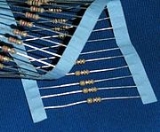
Through-hole technology
Encyclopedia
.jpg)
Lead (electronics)
In electronics, a lead is an electrical connection consisting of a length of wire or soldering pad that comes from a device. Leads are used for physical support, to transfer power, to probe circuits , and to transmit information...
s on the components that are inserted into holes (PTH - Plated Through-Hole) drilled in printed circuit board
Printed circuit board
A printed circuit board, or PCB, is used to mechanically support and electrically connect electronic components using conductive pathways, tracks or signal traces etched from copper sheets laminated onto a non-conductive substrate. It is also referred to as printed wiring board or etched wiring...
s (PCB) and soldered
Soldering
Soldering is a process in which two or more metal items are joined together by melting and flowing a filler metal into the joint, the filler metal having a lower melting point than the workpiece...
to pads on the opposite side either by manual assembly by hand placement or by the use of automated insertion mount machines.
Through-hole technology almost completely replaced earlier electronics assembly techniques such as point-to-point construction
Point-to-point construction
Point-to-point construction refers to the method in which electronics circuits were constructed before the 1950s. Point-to-point construction is still used to construct prototype equipment with few or heavy electronic components....
.
From the second generation of computers
History of computing hardware
The history of computing hardware is the record of the ongoing effort to make computer hardware faster, cheaper, and capable of storing more data....
in the 1950s until surface-mount technology became popular in the late 1980s, every component on a typical PCB was a through-hole component.
While through-hole mounting provides strong mechanical bonds when compared to surface-mount technology
Surface-mount technology
Surface mount technology is a method for constructing electronic circuits in which the components are mounted directly onto the surface of printed circuit boards . An electronic device so made is called a surface mount device...
techniques, the additional drilling required makes the boards more expensive to produce. They also limit the available routing area for signal traces on layers immediately below the top layer on multilayer boards since the holes must pass through all layers to the opposite side. To that end, through-hole mounting techniques are now usually reserved for bulkier components such as electrolytic capacitor
Electrolytic capacitor
An electrolytic capacitor is a type of capacitor that uses an electrolyte, an ionic conducting liquid, as one of its plates, to achieve a larger capacitance per unit volume than other types. They are often referred to in electronics usage simply as "electrolytics"...
s or semiconductor
Semiconductor
A semiconductor is a material with electrical conductivity due to electron flow intermediate in magnitude between that of a conductor and an insulator. This means a conductivity roughly in the range of 103 to 10−8 siemens per centimeter...
s in larger packages such as the TO220
TO220
The TO-220 is a style of electronic component package, commonly used for transistors, silicon-controlled rectifiers, and integrated circuits. The "TO" designation stands for "transistor outline". TO-220 packages have three leads. Similar packages with two, four, five or seven leads are also...
that require the additional mounting strength, or for components such as plug connectors or electromechanical relays that require great strength in support.
Design engineers often prefer the larger through-hole to surface mount parts when prototyping because they can be used with breadboard
Breadboard
A breadboard is a construction base for prototyping of electronics. The term is commonly used to refer to solderless breadboard ....
s, making them easier to handle, insert, and solder.
A rule of thumb
Rule of thumb
A rule of thumb is a principle with broad application that is not intended to be strictly accurate or reliable for every situation. It is an easily learned and easily applied procedure for approximately calculating or recalling some value, or for making some determination...
for creating a through-hole on a PCB is to make the drill diameter 0.019” (0.48mm) larger than the part’s lead. Horizontal installation of axial-leaded through-hole parts (e.g. resistor, capacitors, and diodes) is done by bending the leads 90 degrees in the same direction, inserting part in the board, bending leads located on the back of the board in opposing directions to improve the part's mechanical strength; finally, soldering the leads such that the solder seeps through to both sides of the board. Later the assembler cuts off the excess leads.
Installation of radial-leaded parts (e.g. LED
LEd
LEd is a TeX/LaTeX editing software working under Microsoft Windows. It is a freeware product....
s and electrolytic capacitor
Electrolytic capacitor
An electrolytic capacitor is a type of capacitor that uses an electrolyte, an ionic conducting liquid, as one of its plates, to achieve a larger capacitance per unit volume than other types. They are often referred to in electronics usage simply as "electrolytics"...
s) and IC
Ic
IC, ic, or i.c. may stand for:In computing and technology:* .ic.gov, a second-level domain name administered by the US Government for members of the intelligence community* Integrated circuit* Initial condition...
s are done in the same manner except the parts are already formed in a 90° direction.
See also
- Via (electronics)Via (electronics)A via is a vertical electrical connection between different layers of conductors in a physical electronic circuit.- In IC :In integrated circuit design, a via is a small opening in an insulating oxide layer that allows a conductive connection between different layers. A via on an integrated circuit...
- Board to board connectorsBoard to board connectorsBoard to board connectors are used to connect printed circuit boards , electronic components that contain a conductive pattern printed on the surface of the insulating base in an accurate and repeatable manner...
- Surface-mount technologySurface-mount technologySurface mount technology is a method for constructing electronic circuits in which the components are mounted directly onto the surface of printed circuit boards . An electronic device so made is called a surface mount device...

